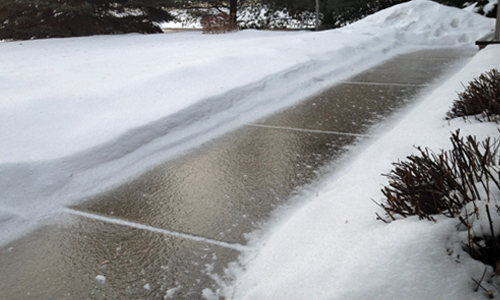How to keep your pavement surfaces from becoming icy
How to keep your pavement surfaces from becoming icy
The cold season can bring heavy winter storms that leave you spending the majority of your free time shoveling snow. In fact, most homeowners and business owners alike, list snow and ice removal as a common pet peeve. Luckily, there are several options available to help prevent your pavement surfaces from becoming icy. It’s just a matter of deciding on which method will work best for you! Here are a few options you should consider:
Clear Debris Before the Snow Hits
To keep your pavement in good condition all winter long, you should clear the area of debris before the snow arrives. This will help you identify any issues that need immediate attention like cracks or potholes that need to be fixed. This also ensures that large pieces of debris don’t freeze and damage the surface of your pavement. Large pieces of debris can also damage snowplows, so cleaning your pavement in advance is one of the best ways to ensure it remains in good shape when spring finally rolls around.

Consider Ice-prevention Methods
Rock Salt
Sodium chloride, also known as rock salt, is often used to melt away ice and stop new ice from forming on roads, sidewalks, and other areas. It’s an affordable treatment option, and easy to access. You should, however, keep in mind that salt exposure can be harmful to animals and damage shrubs and plants if overapplied. Over time, rock salt can also damage concrete and cause metals to rust more quickly. The chemical should not be applied near water sources, as the runoff can pollute local waterways.
While this is toted as one of the more efficient methods for melting ice, rock salt can also be dangerous for the environment. You should keep this in mind before using it.
Sand or Gravel
Sand or gravel can be used on top of snow or ice to add traction and help prevent slipping on roadways, sidewalks, driveways, and other pavement surfaces. Although it will not melt snow as well as salt does, when applied properly, it provides extra grip. It’s also much safer for the environment and works at any temperature. Sand and gravel do not dissolve like ice, so you will need to remove it when the snow melts.
Fill in Cracks and Sealcoat
Sealcoating is a process that must happen before it gets too cold outside. For proper curing, the average nightly temperature outside should be at least 50 degrees. If you’ve already missed your window, it’s not too late to fill in cracks to help protect your pavement surface during the long winter.
Monitor for Pooling Water
If water is pooling now, it’s like this could result in a pothole later, after the snow melts. Keep your pavement free of standing water by making necessary repairs with a local and reputable contractor.
Shovel Frequently
Shoveling is the best way to remove snow and standing water over the winter months. It’s best to remove snow before it has a chance to melt and cause water damage.
Is your pavement prepared for the long winter? Contact Tigard Sand and Gravel today to request a quote!
